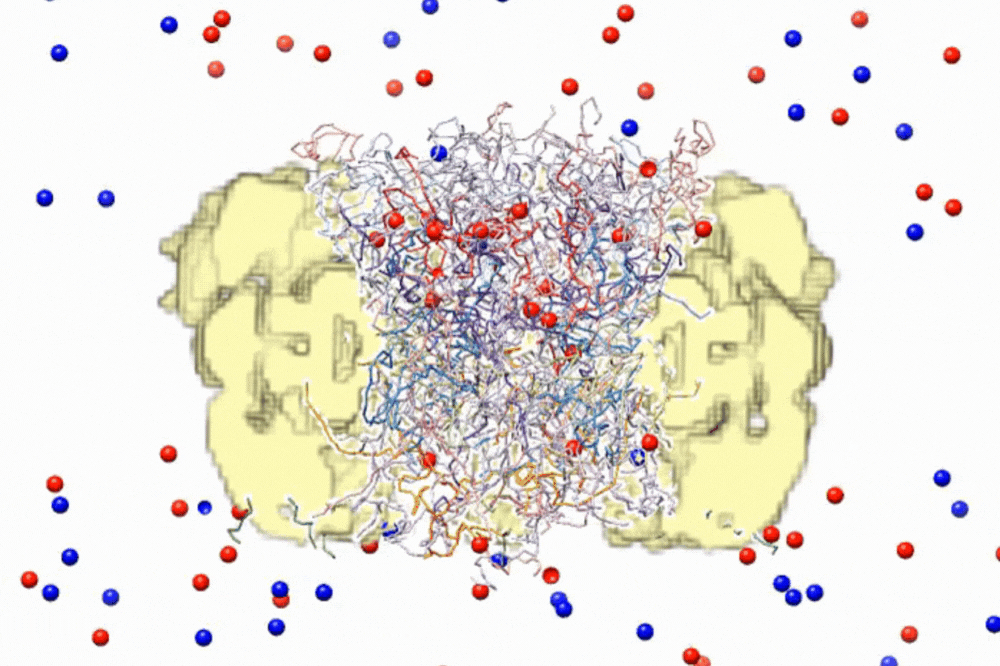
A model of transport through the nuclear pore complex. The blue spheres represent macromolecules that do not interact with the selectively permeable barrier of the complex, while the red spheres represent macromolecules that do. (Credit: Barak Raveh)
Nuclear pore complexes (NPCs) are tiny but sophisticated gatekeepers that control the flow of materials between a cell's nucleus and its cytoplasm by quickly selecting which molecules to transport across the nuclear membrane. Because NPCs are involved in most key cellular processes, when the transport system goes awry, numerous diseases can result, especially those of a neurodegenerative nature.
How each NPC makes a split-second decision about which molecules to allow to pass through its molecular gate is one of biology's oldest mysteries. Now researchers from The Rockefeller University, working with an international team of scientists led by the Hebrew University of Jerusalem, have unveiled an integrative experimental and computational map of macromolecular transport through the NPC-the most complete picture yet of how these remarkable gateways choreograph the traffic between the nucleus and the cytoplasm.
Published in PNAS, the model opens new avenues for medical and biotech innovation.
"We can now model genetic or pharmacological perturbations and then experimentally test the most promising ones," says Michael P. Rout, head of Rockefeller University's Laboratory of Cellular and Structural Biology, where he and his team have studied NPCs for decades. "For example, we can study the molecular basis of numerous NPC-associated genetic diseases and evaluate NPC-targeting therapeutics."
A dance across a bridge
Scientists have long known that the traffic flow moderated by NPCs is a highly regulated, highly selective and rapid process, says Rout, who researches the role the complexes play in gene expression regulation and maintenance.
"Even though each NPC is only about one five-hundredth the width of a human hair, it lets millions of molecules meant for transport pass per minute while screening out the rest," adds lead author Barak Raveh, of the Hebrew University of Jerusalem. (Other partnering institutions were the University of California, San Francisco, and Albert Einstein College of Medicine.)
But how NPCs differentiate so quickly between molecules of different sizes, purposes, and complexity has remained elusive, in part because these molecular gates are so small that direct observation of their inner workings has been nearly impossible.
Earlier models envisioned the NPC as a mechanical gate, or more recently as a cohesive hydrogel forming a sieve with fixed pore sizes. However, these views are difficult to reconcile with the NPC's composition and architecture; the observed speed, adaptability, and reversibility of nucleocytoplasmic transport; and the rapid passage of even large molecular assemblies through the pore.
For the current study, the researchers combined years of fragmented experimental data and theoretical insights into a single computational framework to map out what happens at the molecular level on timescales as short as a few thousandths of a second.
This integrated approach allowed them to identify 10 molecular design features that work together to ensure the NPC's extraordinary efficiency and resilience.
The central feature is a dense, dynamic "forest" of flexible protein chains called FG repeats that crowd the pore interior. Openings in this highly dynamic and restless thicket continually and rapidly appear and disappear, which permits small molecules to pass through the pore. Larger molecules, however, are only granted passage if they are accompanied by nuclear transport receptors. These specialized molecules slide seamlessly between protein chains, leading their molecular cargo fluidly through the dense, fluctuating field. The system's redundancy and exponential sensitivity make it both robust and finely tunable.
"The transport mechanism can be imagined as a vast, ever-shifting dance across a bridge," Rout says. "The FG repeats form a dynamic, restless crowd that allows only those with the right dance partners-the nuclear transport receptors-to pass through. Without these partners, flat-footed molecular spectators who cannot dance are turned back."
Validated against multiple independent datasets, the computational model also accurately predicted previously unobserved transport behaviors and revealed how "fuzzy," transient interactions between transport receptors and FG repeats dramatically boost efficiency, allowing the system to transport even massive cargoes like ribosomal subunits or viral particles.
A potential biotechnological revolution
The model also provides insight into diseases that develop when this transport system fails, such as cancer, Alzheimer's, and ALS.
Additionally, the model could serve as a blueprint for designing artificial nanopores-synthetic versions of the NPC that could revolutionize biotechnology, from targeted drug delivery to biosensing.
"Because NPCs sit at the crossroads of key cellular systems like transcription, translation, and the cell cycle, we can now begin to model how these systems work together, and perhaps even reach whole-cell modeling," Rout adds. "Nevertheless, this is just a start. There remain big unknowns about how nuclear transport works at the molecular level, and so we would next like to investigate the specific roles of different FG nucleoporins and the exact cargo pathways."






